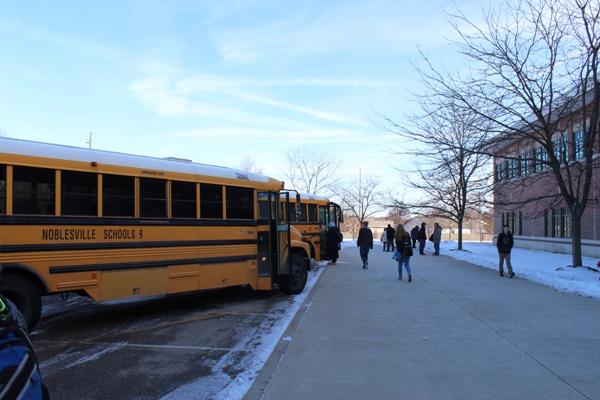Talk of eLearning replacing snow days continues

Photo by Photo by N. Copenhaver
NHS students board the buses on a cold January afternoon. To keep students from having to bear the elements, Superintendent Beth Niedermeyer may choose to use eLearning instead of in class time in the case of extreme weather.
January 24, 2015
Frigid temperatures and deep, fluffy snow tug at the bare necks and booted heels of hundreds of waiting students as they wait in the early morning silence for their yellow-orange haven of warmth. After making their way through four classes, they head out to the buses to make the journey back home among the icy roads and sub-zero temperatures.
Deciding to cancel school to handle these extreme conditions is a choice Superintendent Beth Niedermeyer must make, sometimes on a daily basis. But with the district’s technological abilities, Niedermeyer may have another choice.
Using eLearning as a substitute for classroom hours is a ready solution as a result of the District’s 1:1 Initiative.
Should the two flex days, January 18 and February 16, be used, Niedermeyer will decide whether she will seek the Department of Education (DOE)’s approval to use eLearning to make up any missed days, rather than the traditional solution of adding make-up days on to the end of the school year.
Over 35 schools in the state have already requested and received approval to use eLearning on a snow day in order to prevent the district from having to make up the day. Noblesville Schools could potentially make up snow days with eLearning either by having teachers give out assignments online for the day that was to be missed or by doing make-up eLearning assignments like the way hours were made up last year. This decision has not been finalized yet, but it will be should the district request the DOE’s permission to use eLearning.
Both advantages and disadvantages are considered in making the decision.
NHS Assistant Principal Mr. Kevin Stuckwisch said, “…eLearning allows us to get out of school earlier and preserve an already short summer break.”
He also noted that eLearning would prevent conflicts caused by adding days to the end of the year, such as with graduation or family plans.
Despite the benefits, changing snow days to eLearning days still has its potential detriments.
“The biggest disadvantage is that eLearning has yet to be defined for elementary-aged children who do not have their own iPads,” Stuckwisch said.
According to Stuckwisch, if the elementary schools were excluded from using eLearning, they would have to make up their days at the end of the year, causing the school year to unfavorably end at a different time for the elementary schools.
“Also, there is a concern that our special needs students would not receive the same services to which they’re accustomed on these types of days,” Stuckwisch said.
Despite personally favoring a physical classroom, Stuckwisch “believe[s] that we live in an age where technology allows us constant access to information and the ability to learn 24/7.”
Stuckwisch said that eLearning promotes that age of technology, in addition to giving students experience with online learning.
“eLearning days give students the potential to learn in ways traditionally limited by our daily schedule and the walls of the classroom.”
Students’ preferences vary in regards to the options.
“Last year, the eLearning worked,” said sophomore Brooke Franz. She prefers making up the hours by using eLearning assignments for each class. “I’d want to get it over with…I don’t like when they add it on to the end of the year because it just makes the school year longer and your summer shorter.”
But not all prefer using eLearning.
“[We should] just add days to the end of the school year,” said junior Maddie May. “The other options just don’t make sense…Having teachers make last minute plans doesn’t seem like a good idea.”
If Noblesville Schools doesn’t have any more snow days, then a decision won’t be necessary. But if needed, Niedermeyer will decide how the District will fill the state required hours, which will determine how long students will bear the weather conditions.



